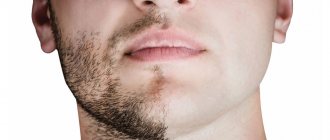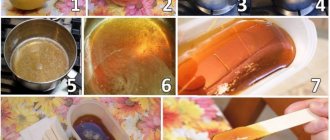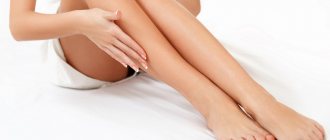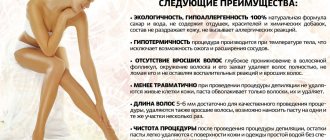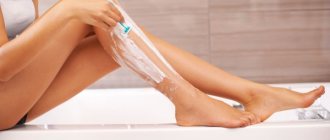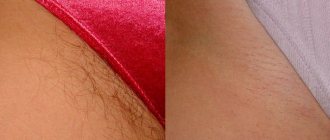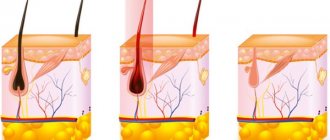Category: Epilation
Hair removal using wax or sugar is becoming a popular procedure. Dreaming of getting rid of excess hair on the body, girls and women use razors less and less, because this tool removes only the visible part of the hairs, and they grow back quickly.
Therefore, in order for the skin to please its owners with smoothness for as long as possible, they resort to either sugar or lipid hair removal. It is necessary to consider which is better - waxing or sugaring, and what are the advantages and disadvantages of these two methods.
Principles of operation of methods
Both hair removal methods allow everyone to get rid of excess hair on their arms, legs, armpits and bikini area for several weeks, since during these procedures the hair is removed along with the roots (bulbs).
Waxing, or waxing, is performed using a composition containing bee product, pine resin rosin, paraffin and natural oils. Its consistency can be hard (in the form of granules or briquettes) and soft (sold in jars or roller cassettes); strips with a sticky composition applied to them are widespread.
Before the hair removal procedure, hard wax is heated to +50°C so that it becomes viscous and melted, and then, after cooling to +40°C, it is applied to a small area of skin using a special spatula. The layer of composition should be thin and uniform. A paper strip is placed on top, pressing the hand to the body. The sticky substances contained in the wax penetrate under the skin under the influence of heat and, upon reaching the hair follicles, envelop them. You need to sharply pull the strip in the direction opposite to the hair growth, which will break out along with the roots.
The procedure using a hot composition is carried out in a cosmetology room.
Soft wax, unlike hard wax, does not need to be heated, which is why this type of hair removal is called cold. Ready-made strips with the composition purchased in the store are also not heated, but their temperature should not be lower than +20°C. The cold hair removal technique is otherwise no different from hot waxing. Sometimes wax strips can be applied to the skin several times if individual hairs remain in the area. Cold methods are easy to perform without the help of a cosmetologist at home.
After completing all types of procedures, the skin should be wiped with olive, coconut or lavender oil to remove wax residues, since it is not washed off with water. For two days after hair removal, you need to protect your skin from exposure to ultraviolet rays, do not sunbathe or go to the solarium to avoid inflammation of the epidermis or its pigmentation.
Although the method of sugar hair removal (sugaring) appeared in Russia recently, it, like wax, already has a whole army of fans. You need to know how sugaring differs from waxing and what they have in common.
The main difference is the epilation material. Removing vegetation from the body is done using sugar paste. It contains only natural ingredients: water, sugar and lemon juice. When comparing wax with sugaring, you need to know that masters apply sugar paste to the skin heated to a temperature of +37...+39°C, as in the hot waxing procedure. But, unlike hair removal with resins, the sugar composition is never used cold.
Otherwise, the principle of sugaring is similar to the waxing method. The heated paste is applied to the area with hair, hardens on it, turning into a cake, which is removed from the body with a sharp movement along with the hairs stuck to it. This method does not require paper strips. After the procedure, the remaining sticky paste is easily washed off with warm water.
What is the difference between sugaring and waxing?
Hair removal has been used since the time of Cleopatra. It is known that viscous compositions of honey, wax and sugar were used for hair removal. Modern women also use these products for sugaring and waxing procedures. In this connection, it is necessary to know the differences between sugaring and waxing.
Sugaring is a hair removal technique in which a special sugar paste is applied to the skin. Moreover, caramel can be a purchased product or a self-prepared product. The paste is applied against hair growth and after some time, it is removed from the surface of the skin with a sharp jerk. The product can be applied by hand or with a spatula; specialists sometimes place strips of fabric or paper on top of it (bandage technique).
The paste used for sugaring can have varying degrees of thickness. It depends on the area of its application. For example, to remove coarse hair in the deep bikini area, you need to use a thicker emulsion. The composition of the paste can be enriched with various useful components: lemon juice, honey.
Sugaring is a popular procedure due to its minor pain and long-lasting effect. Hair removal with sugar paste allows you to keep your skin smooth for several weeks.
Sugaring requires some preparation. This preparatory stage allows you to minimize discomfort during the procedure and increase the duration of the effect.
Experts point out that it is advisable to treat the skin with a scrub for a few days in order to remove dead particles from the surface. Scrubbing ensures reliable adhesion of sugar paste and hairs. Immediately before sugaring, you should degrease the skin, take a shower or bath, you can also apply a compress to open the pores and simplify the hair removal procedure.
Attention! If you have a low pain threshold, it is advisable to take a painkiller half an hour before hair removal. Do not apply any cosmetics to the skin.
The algorithm of actions includes:
- applying the paste to the skin in a dense layer against the direction of hair growth for maximum penetration of the product;
- if necessary, place fabric or paper strips on the paste;
- with a sharp movement, the paste is torn off in the direction of hair growth;
- moisturizing the skin is carried out by applying an appropriate cream.
Waxing is used not only by women, but also by men. The method can be used if there is irritation after shaving. The procedure has several varieties depending on the temperature at which the wax is used:
- warm;
- cold;
- hot.
Hot wax is used exclusively in salons. To perform this cosmetic service, a specialist must have special permission and appropriate qualifications. It is advisable to use hot wax to remove hair growing in the armpits or bikini area. The underarm and deep bikini areas are considered delicate and sensitive areas.
When the temperature of the wax is reduced to 50 ° C, it is applied to the skin in the form of cakes in the direction of hair growth. After a short amount of time, it is removed from the skin against the main hair growth.
Attention! Before applying the wax, the technician checks the temperature of the product using his or her wrist.
The warm wax technique is used at home and in salons. The wax strip is applied in a thin layer in the direction of hair growth using a cartridge. Before applying the wax, it is heated to 50 ° C. After treating a certain area, a strip of paper is placed on the product, which is torn off in the direction of hair growth after a few minutes.
Attention! Warm wax hair removal is not recommended for use in sensitive areas, which include the armpits and deep bikini area. It is best used to treat the legs, abdomen or arms.
At home, women use strips with wax already applied, which they heat in their hands, attach to the desired area, and then tear off. It is noteworthy that during waxing or vaxing, skin care is the same as during sugaring. The procedures have the same list of activities included in the preparation stage. Contraindications to hair removal techniques are also the same.
Important! Unlike waxing, sugaring can be performed on women with a history of varicose veins.
Thus, the similarity of the procedures comes down to the following points:
- hair removal from the root;
- the appearance of new hairs after 10 or more days;
- hair length for procedures is 5 mm on average;
- Constant manipulation allows you to reduce the intensity of hair growth and hair thickness;
- Possibility of use at home;
- application for various zones;
- implementation of procedures using bandage, spatula and manual techniques;
- almost identical list of contraindications.
To decide whether film wax or sugaring is better, you need to look at the differences in hair removal methods. The techniques have both common and different characteristics.
Difference between waxing and sugaring:
- The product used. When sugaring, sugar paste is applied to the skin, and when waxing, wax is applied.
- Method of application. When sugaring, the paste is applied against hair growth and torn off in its direction. When performing waxing, the master acts exactly the opposite.
- Soreness. Tearing the paste along the hair growth significantly reduces the intensity of pain. Moreover, the surface area to be treated during waxing is larger.
- Safety. This point is significant. It is known that sugar paste contains a small amount of natural ingredients, which reduces the risk of adverse reactions. Wax often contains synthetic substances that can cause allergies. When waxing, there is a risk of burns due to the use of hot wax. Sugar paste is heated only to 38 °C.
- Duration of sessions. Treatment with sugar paste involves applying the product to small areas. The procedure using wax is much faster due to the treatment of large areas.
- Efficiency. Hot wax grips the hair more securely. When carrying out sugaring, there is often a need to re-apply the paste, which also does not always guarantee a good result. Sometimes the remaining single hairs have to be removed using tweezers. This increases the duration of the manipulation.
- Economical. A piece of sugar caramel can be used several times. You can make your own sugar paste from available products. Thus, sugaring is cheaper than waxing.
Benefits of waxing/sugaring
You need to figure out what to choose - sugaring or wax. Many women find it difficult to choose between them, because both procedures are superior to each other in some respects. If you decide to remove excess hair from your body using sugar hair removal, know that its advantages are as follows:
- The composition for sugaring can be prepared at home, so, unlike wax, it will require less money.
- Thanks to the natural components included in the sugar paste, the skin is not subject to irritation and allergic reactions.
- Since hair during sugar hair removal is always pulled out in the direction of its natural growth, and not against it, as with the wax method, it does not break at the surface of the skin and does not grow into it.
- After removal of vegetation, the skin is easily and quickly cleansed.
- The risk of getting a burn to the epidermis during this procedure is small, because the temperature of the paste is low.
Waxing also has several advantages over sugaring:
- A mixture of paraffin, resins and wax can be applied to a large area of the skin, so the time spent on the procedure is much less than for sugar hair removal.
- The composition captures short-length hairs, and this circumstance allows you to remove unnecessary hair from one area of the body in 1 step. And if sugar paste is used instead of wax, hair is removed only the second or third time.
- With regular waxing, the hairs grow thinner, the hair becomes smaller and it becomes easier to get rid of it each time.
Thus, if you want to save time on the hair removal procedure, then you shouldn’t think long about the dilemma of what to use - waxing or sugaring; waxing will win here. If you care about the beauty and health of your skin, choose sugaring.
Sugaring or waxing: the main differences between the procedures
Let's figure out how sugaring differs from waxing - there are few differences between the procedures, but they still exist:
- During sugaring, the paste is applied against hair growth and removed according to the growth of hair shafts. In turn, during wax depilation, the paste is applied to the skin along the hair growth and removed against the hair growth. All other differences between sugaring and waxing are somehow related to these features of the procedures.
- After sugaring, there are almost no ingrown hairs , but after waxing, hair ingrowns very often.
- Different working temperatures of the paste . As a rule, for waxing they use a paste heated to a high temperature (although cold wax can also be used) than for sugaring. On the one hand, high temperature helps to activate blood flow and metabolic processes, and on the other hand, it can be dangerous in case of neoplasms, rosacea and varicose veins.
- Another difference between sugaring and wax hair removal (depilation) is that the remnants of sugar paste are washed off with water , and the remnants of wax-based paste are removed with special compounds (for example, chlorhesidine).
- Sugar-based pastes practically do not cause allergies , which cannot be said about wax-based formulations. The above applies to sugaring pastes consisting only of sugar and water, but if plant extracts are added to the product, it can also cause allergies.
Disadvantages of waxing/sugaring
Despite the advantages of both procedures, each of them has disadvantages, which should also be looked at carefully.
Disadvantages of waxing:
- Sometimes the hot wax method results in skin burns, although professionals try to prevent this from happening.
- In people sensitive to irritants, the components of the composition cause allergies. But lemon juice contained in sugar paste can also cause skin irritation, so the difference with sugaring in this case is insignificant.
- It takes a long time to remove wax residues from the skin with oils.
Cons of sugar hair removal:
- Doesn't remove all hairs the first time.
- The procedure is a lengthy process as one piece of paste can only cover a small area.
- Sugar, having firmly adhered to the skin, can remove not only hair, but, compared to wax, it can destroy the cellular layer of the epidermis more strongly.
- The process of working with paste in the armpits and bikini area is more difficult.
It is necessary to take into account all the nuances of both methods before resorting to any of them.
Main contraindications
The step-by-step instructions for home sugaring are very simple, which is why many women decide to undergo a cosmetic procedure at home. But it has a number of contraindications that must be taken into account:
- herpetic, infectious or fungal skin lesions;
- wounds, abrasions, hematomas in places where the sugar composition was applied; scrubbing in such cases is also prohibited;
- diabetes;
- pregnancy period;
- thrombophlebitis, varicose veins of the lower extremities;
- presence of cancer;
- high blood pressure;
- visible blood vessels appearing on the surface of the skin;
- dermatological diseases - eczema, psoriasis, lichen.
Sugaring done at home is prohibited if a person has hypersensitivity to the ingredients in the wax paste.
Contraindications for waxing/sugaring
Every person who wants to get rid of excess hair using sugar or wax should be aware that not everyone is allowed to carry out such a procedure as hair removal.
People with diabetes and HIV-infected people should not remove body hair, as an infection can easily be introduced under the skin, which will cause a purulent-inflammatory process. Even after superficial trauma by wax or sugar, the skin of people with these diseases recovers slowly. Epilation is not recommended for pregnant women.
Since sugaring and waxing are accompanied by unpleasant sensations, they should not be done by people with a low pain threshold. For the same reason, women who suffer from coronary heart disease and hypertension or are in the second half of the menstrual cycle, when the pain is felt more strongly, should avoid waxing hair and using sugar paste.
Video: how sugaring is done
Attention! An argument in favor of choosing sugaring or waxing can be the price of the procedure (the table shows the average prices for sugaring and waxing in Moscow salons):
| Processing area | Sugaring price | Waxing price |
| Mustache/chin | 500/600 rubles | 350/500 rubles |
| Shin/thigh | 2,500/2,500 rubles | 500/800 rubles |
| Classic bikini/deep bikini | 1,900/2,500 rubles | 600/1,600 rubles |
| Back/chest | 2,500/1,300 rubles | 1,000/600 rubles |
| Armpits | 1,000 rubles | 400 rubles |
Possible consequences of waxing/sugaring
In addition to infectious processes caused by microbes and viruses entering the skin (herpes, Staphylococcus aureus, hepatitis) and allergic reactions that irritate the epidermis, wax and sugar procedures can lead to the following consequences:
- If a person takes antibiotics or oral contraceptives, their skin may become sensitive. As a result, after hair removal, itching or swelling of the body area will appear.
- In people with papillomas and moles in the bikini area, sugaring and the wax method can contribute to the degeneration of benign formations into malignant ones if they are damaged by the paste and composition.
- If epilation is carried out incorrectly, bruises and bruises appear in areas with removed vegetation.
- The most common problem after poor-quality waxing and sugaring is ingrown hairs under the skin. Regular use of scrubs helps reduce its likelihood.
If you have no dangerous diseases or contraindications and hair removal is done by a professional under sterile conditions, then you don’t have to worry about the quality of the sugar or wax procedure and its safety for health.
Questions
How often should you do sugaring?
Sugaring is one of the most effective depilation procedures currently available, as all hairs are removed during the process. Since the hair on the human body grows unevenly and is in different growth phases, we can talk about repeating the procedure, for example, for the legs after an average of 3-4 weeks. It is important to keep in mind that after the procedure the hair becomes thinner and loses pigment, so even visually if the hair grows back you will notice a difference.
How painful is this procedure?
Sugar hair removal is a relatively painless procedure. Mild discomfort occurs only when the paste is torn off, but this is only a split second. When removing hair from delicate areas (armpits, bikini), you can use a special anesthetic intended exclusively for sugaring.
Who is better off giving up sugaring or abstaining at one time or another?
As already noted, contraindications to the sugaring procedure are open wounds on the skin, as well as abrasions, moles, and papillomas. There are no other contraindications.
How (and is it possible) to slow down hair growth?
Special inhibitor lotions will help slow down hair growth. Each manufacturer has its own preparations and instructions for use, so if you are going to do sugaring at home, you should study this issue in advance and purchase a product that is suitable in price and quality.
How to reduce the risk of ingrown hairs?
To avoid ingrown hairs, you need to follow two rules. First, choose professional products for home sugaring or a highly qualified certified sugaring master who follows the “Sugar Depilation Procedure Protocol.”
Secondly, do not neglect home care. So, on the 3rd day after the sugaring procedure, you can, if necessary, use lotion against ingrown hairs. On the 5th day, you can use a body scrub suitable for your skin type (use once a week, but not more often). Plus, daily moisturizing with special creams is recommended from the first day after sugaring.
On the Internet you can find a lot of recipes for sugaring mixtures at home. Does this really work?
In the case of a home sugaring procedure, it is better to use a professional paste and pay attention to certain points:
- Sugar paste should not contain citric acid - otherwise skin pigmentation may occur;
- Sugar paste should not contain any chemical additives.
In the case of home-made “self-brew” paste, failure to maintain the sugar-water ratio or adding lemon juice can lead to a low quality product, which will prevent the desired result from being achieved. Also, if the paste is not cooled sufficiently, there is a risk of skin burns. Using a “samovar” paste, you can, of course, remove hairs, but you won’t be able to carry out the procedure efficiently.
How does sugaring in a salon differ from sugaring at home?
Sugaring at home
Sugaring in specialized studios and beauty salons is carried out by certified masters who master all sugaring techniques. At home, you can remove unwanted hairs using only the bandage technique (using special bandage strips). A professional master works exclusively with manual and spatula techniques.
Professional cosmetics differ from non-professional ones in the following ways:
- Special composition - high content of active components, expensive raw materials, original and patented ingredients;
- All cosmetics are hypoallergenic (there are no artificial flavors or fragrances);
- Ergonomic and economical;
- Mandatory certification of cosmetics and production.
Can sugaring cause allergies? How to check this?
When the sugaring procedure is carried out correctly and professional products are used, allergic reactions do not occur. Simply because the individual skin reaction to hair removal - and this is what many understand by “allergies after sugaring” - is not an allergic reaction.
Who is ideal for sugaring and not something else?
Sugaring has no contraindications and is recommended for almost everyone. I would say that the procedure is suitable for busy women and men who can allocate a minimum amount of time for hair removal, for pregnant women, for those with sensitive skin. Even varicose veins are not a contraindication, so everyone should try it at least once.
What's more expensive?
In order not to harm their health with poor-quality and inept hair removal at home, people prefer to turn to professionals. A method using wax (cold or hot), performed in a cosmetology salon, will cost less than sugaring. The price also depends on what area of the body the hair removal will be performed on. The most expensive procedure is for the legs, the cheapest is for the armpit area.
Having studied all the pros and cons of waxing and sugaring, each woman will choose the method that will be best for her. Both procedures have a large number of supporters, because they make the skin smooth for a long time.
conclusions
The choice between waxing and sugaring must be made individually, taking into account the type and condition of the skin, your own pain threshold and other factors. Both wax and sweet paste remove hair for a long time - up to a month. If you evaluate which is more painful, waxing or sugaring , it is preferable to use sugar paste. Its additional advantages are its natural composition, hypoallergenicity, and the possibility of use in sensitive areas.
Wax strips allow you to perform depilation with minimal time and effort. But with a low pain threshold, waxing causes very unpleasant sensations, and if you are prone to allergies, severe skin irritation can occur. To understand which hair removal method is best for you, you need to try each of them and choose the best option from your own experience.
Pros and cons of waxing
Removing skin hair using waxing has long been considered the best way to remove hair, since its advantages are undeniable:
- Convenient and fast - especially after home cassette epilators that operate on electricity and easily heat wax to the desired temperature have become available on the market. A convenient roller applicator allows you to quickly apply hot wax to the skin, and wax strips can also be quickly applied on top. Hair removal occurs in one movement.
- Long-lasting results - hairs are removed along with the root, so the skin remains smooth for 3-4 weeks.
- Safety – it is impossible to get hurt during wax hair removal, since no sharp or dangerous objects are used during the procedure, only wax and paper.
- There are no contraindications - absolutely all women can use wax.
Disadvantages of using wax:
- Ingrown hairs are the main problem with wax use. This is due to the fact that hairs are removed against growth. Some of them break or bend. Subsequently they grow and inflammation occurs.
- Pain – Waxing is a fairly painful procedure, especially on sensitive areas.
- Skin irritations – hot wax can sometimes cause irritation or allergic reactions. If the first goes away quickly enough, then the second indicates that this method is not suitable for you.
- Remaining hairs – waxing is done only once on one area of the skin. If after the strip has been removed there is still hair left, it can only be removed with tweezers, which takes time. If you carry out the procedure on the same area a second time, you can get severe irritation on the skin or even a burn.
Features of the wax method
Waxing is also one of the methods that makes it possible to get rid of unnecessary hair on the body. Moreover, this method is widespread among both men and women.
Types of procedures
There are three methods of waxing: cold, hot and warm. The difference between them is as follows:
- Hot wax is mainly used in special salons, since such a procedure requires special permission and must be carried out by a specialist cosmetologist. This method is suitable for the most sensitive areas such as the bikini area and armpits. The wax is placed in a special container and heated to a temperature of 80 degrees Celsius. Then, when it cools down a little (the cosmetologist usually tests the temperature by applying it to the wrist area), it is applied to the selected area in the direction of hair growth. Leave for two minutes and then tear off in the direction against hair growth.
- Depilation with warm wax can be carried out not only in the salon, but also at home. This method is carried out using special wax cartridges. Usually it is heated to a temperature of 50 degrees, then applied to the surface of the skin, after which a strip of paper is glued on top, leaving one edge free. After a few minutes, tear off the strip. This method is most suitable for depilation of arms, legs and abdomen.
- The easiest way is to remove excess hair using special strips on which a layer of wax is applied. It is enough to hold such a strip in your hands for a little while so that it flares up, then attach it to the depilation area, hold it a little and tear it off. This method is very convenient to use at home.
Wax and sugar paste for sugaring: composition and preparation features
Waxing, as its name suggests, is carried out with a mixture, the main component of which is natural beeswax. This product contains vitamin A, considered a powerful antioxidant that slows down skin aging. Also, this gift of nature has moisturizing, softening, wound-healing and antibacterial properties.
To prepare the mass, the bee product must be cooled slightly in the refrigerator, then grated, melted in a water bath, and then poured into a special jar.
It is advisable to use the mass warm, because it cools and hardens quite quickly.
As for sugar paste for sugaring, the main component here is sugar. To prepare the mixture, you need to pour 8 tablespoons of this product into a saucepan, then add 1 tablespoon of hot water and the same amount of citric acid. If the skin is sensitive, the amount of sugar should be increased to 10 tablespoons and add half a tablespoon of aloe juice. Honey is also an excellent remedy. It moisturizes and softens the skin.
After all the ingredients are in the pan, you need to mix them thoroughly and cook the mixture over low heat until it turns out sticky, like caramel. The finished mass for sugaring must be poured into a special jar.
